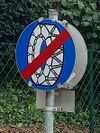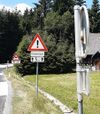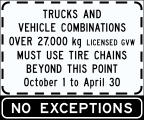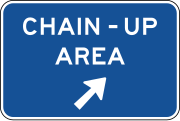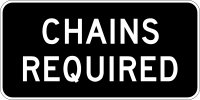Proposal:Snow chains
| Snow chains | |
|---|---|
| Proposal status: | Proposed (under way) |
| Proposed by: | Trapicki |
| Tagging: | snow_chains=*;
|
| Applies to: | way |
| Definition: | Requirements (possibly with conditions and variable) to put snow chains on your vehicle when driving on this highway, with places reserved for changing snow chains. |
| Draft started: | 2021-11-09 |
| RFC start: | 2021-11-11, 2022-12-04 |
Statistics
snow_chains=*
snow_chains:conditional=*
snow_chains:variable=*
amenity=chain_change_area
legacy:highway=chain_up_area
Proposal
Tags related to snow chains:
- Restrictions on roads regarding snow chains, with optional applying conditions and if they are variable (not active throughout the whole year)
- Places to put on and/or put off snow chains (which are dedicated and maybe parking restrictions apply)
- Vehicle properties "snow_chains" and "winter_tyres" for conditional tags
Scope
What is not part of this proposal:
- Local Legislation: See Don't map local legislation if not bound to specific objects. In some countries (e.g. Austria), some vehicles (vehicles > 3.5 t) under certain conditions (always at ice or snow) are required to use snow chains. In some regions of France it's compulsory to fit snow chains or have winter tires during winter. This legal requirements shall not be tagged with tags from this proposal. We collect all that information on the separate page Additional Information.
- Winter equipment: Winter tyres, studded tyres, lugs and the like are related to snow chains, but not scope in this proposal, except for the vehicle property "winter_tyres" used in conditionals.
- Traffic signs: Traffic Signs announcing restrictions related to snow chains are not part of this proposal, because this would be part of a different aspect with a much wider scope. The aspect that the restriction may be variable is covered in the proposal.
Rationale


In regions where roads are covered in snow and ice during winter, on sufficiently steep roads motorized vehicles may be required to have snow chains (tyre chains, tire chains, wheel chains) attached. Sometimes, snow chains need to be carried on the vehicle but not (yet) actively put on. Snow chains may also be recommended by traffic signage, without one being fined if snow chains are not used - still important to know. On some road sections like tunnels snow chains may be prohibited.
Special areas may be reserved for putting on (laying chains/fitting chains/chaining up) and/or putting off (removing/chaining off): chain change areas (chain-up/off area, chain bay, chain fitting bay, chain bay). They are reasonable flat, allow rolling the vehicle to facilitate putting the chains on and off, and allow to accelerate safely also in heavy snowfall. One will find them ahead of and after the road section that has possible snow chain restrictons. Most probably these areas will have parking restrictions to ensure that in case they are needed space is available, and vehicles leave as fast as possible.
Often, the requirement to use snow chains is issued variable (on demand) by road authorities during the season or just during severe weather situations, indicated by special road signs that can be covered, flipped open/close, turned sideways, unmounted, or operated from remote electrically/electronically.[note 1] Tagging variable restrictions is important to let mappers and users understand that the road sign may be presented differently in different conditions and times of year. This prevents accidental removal of tags and allows to understand that an invisible or unreadable road sign may be active at some other time of year. This may also apply to to conditional snow chain requirements.
Usually the requirement for snow chains is conditional, most commonly restricted to conditions of ice or snow, but also certain types of vehicles (e.g. trucks, all wheel drive, weight), directions (e.g. downhill), or vehicle equipment (e.g. winter tyres, "winter equipment"); this may also apply to to variable snow chain requirements.
Even though this is quite common in the European Alps and other parts of Europe and the world, we do not yet have any tagging scheme for these things. But they are useful for several reasons:
- It's part of everyday life of drivers/law enforcement/fire brigades etc. in significant parts of the world.
- For routing, it is important to know about existing or possible limitations or equipment that may be necessary, which is especially true for snow chains. As snow chains are only necessary and/or required under certain conditions this may change depending on the time one travels the route, it may even change on short notice during the journey. Knowing the possible limitations beforehand allows to adjust the route or equipment and consider the implications accordingly. Routers could also filter to not require winter equipment. In case snow chains are required, the affected route sections and chain change areas may be shown/listed to help travelers.
- There should be a map that shows or highlights these things. Map needs data.
Tagging
The decision to put on chains is usually understood to be judged by the driver evaluating the road condition; because (metal) snow chains may damage or excessively wear a road, chains should be removed whenever they are not required any more. Please keep in mind that a (conditional) requirement for putting on chains may be shown on roads may also be shown when there is actually no snow, ice, snowfall or general winter conditions in the region. Use common sense.
Key snow_chains=*
Applies to highway=* that apply to motorized vehicles.
| Value | Description | Traffic sign |
|---|---|---|
snow_chains=required
|
Snow chains always required to be put on. | traffic sign symbol: tyre with snow chains on blue circle. |
snow_chains=carrying_required
|
Snow chains have to be carried on the vehicle, but not necessarily put on. The obligation to fit them immediately would have to be announced by a separate snow_chains=required.
|
textual traffic sign |
snow_chains=recommended
|
Snow chains are recommended to be put on. This does not include the obligation to put them on or carry them on the vehicle. While this may first not seem worthy of tagging, there are valid traffic signs for that, and it is valuable information for mapping and routing. | textual traffic sign, e.g. USA, Idaho W 8-1301 [1] [2] |
snow_chains=carrying_recommended
|
Snow chains are recommended to be carried on the vehicle, but not necessarily put on. This state any binding requirement, but helps planing a route and to have an idea what conidtions to expect. | For example recomended to carry for 4WD/AWD vehicles on certain roads in Australia. |
snow_chains=default
|
Only with snow_chains:conditional=*. Expresses that no special requirement is active, and general local legislation regulations apply. Necessary because
|
See local legislation |
snow_chains=prohibited
|
Snow chains never allowed, e.g. in tunnels[note 3]. | textual traffic sign, traffic sign symbol unknown |
In most cases (at least in Central Europe), snow chains will be required conditionally (fixed rule, additional traffic signs) and/or variable (issued by local authorities depending on the actual situation).
Related tags
incline=*
Subkey snow_chains:conditional=*
Standard Conditional restrictions. Use separate snow_chains=* for default value, probably default.
Examples of values:
snow_chains=default,snow_chains:conditional=required @ (snow; ice): Very common, may be indicated by additional snowflake sign.[note 4]snow_chains=recommended,snow_chains:motorcar:conditional=default @ winter_tyres: Snow chains recommended, expect for motorcars (Class N) with winter tyres.snow_chains=default,snow_chains:conditional=required @ flashing_lights: Snow chains required only when the flash lights at the traffic sign are flashing[note 5].
Can be combined with snow_chains:variable=*: A restriction may be both conditional (e.g. specific type of vehicle) and variable (e.g. only shown at specific weather conditions).
Subkey snow_chains:variable=*
Indicates if snow chain requirements are stated on traffic signs in a variable way or permanent/non-variable, and the reason when it would be shown. Possible ways how signs may be shown/hidden include: covered, flipped open/close, turned sideways, unmounted, operated from remote electrically/electronically, etc[note 6].
This is derived from maxspeed:variable=* and should be handled consistent with that, but only values weather and no are sensible here. Please do not use value yes
| Value | Explanation |
|---|---|
snow_chains:variable=weather
|
Snow chains variable/non-permanent required as announced on site, on weather dependent decision of road authorities.
This may be on very short notice only during acute snow fall or ice, or when snowfall is expected, or rather for a long time like "the cold season". There may be times when the sign is not visible or recognizable as such, so please do not remove the tagging if you just can't find or identify the road sign. |
snow_chains:variable=no
|
Traffic sign is known to be permanent throughout the year.
Do not set this value if it is not determined if the restriction is variable or not. |
snow_chains:variable=yes |
Please do not use, adds no specific information!
Use instead |
Can be combined with snow_chains:conditional=*: A restriction may be both variable (e.g. only shown at specific weather conditions) and conditional (e.g. specific type of vehicle).
Value amenity=chain_change_area
![]() area (for provisional tagging,
area (for provisional tagging, ![]() node)
node)
For areas that are primarily dedicate to putting on/putting off snow chains. On purpose, no distinction is made to differentiage between 'chain-up areas' and 'chain-off' areas[note 7]. The areas are by nature usually located at the driving side of the road (no crossing of slippery road) and you put on chains before driving uphill, and put off chains after driving downhill. name=* may reflect the actual intended purpose.
Tagging
| Type | Width | Tags | Extension of area |
|---|---|---|---|
| Wider shoulder, chain bay | single lane, with space to safely change chains | amenity=chain_change_area
|
From the highway=* it belongs to (center line) to the outer edge of the chain change area, for the full length of the area.
Nodes from the |
| Separated area | Lane to drive plus extra space to change chains | amenity=chain_change_area, including roads tagged as highway=service if they are intended to be driven on.
May be combined with |
All the chain change area, but not the area of the highway=* it belongs to.
|
For provisional tagging, ![]() node
node amenity=chain_change_area may be used, with notes=*/fixme=* to allow/encourage full area tagging.
Chain Change Area, Chain Bay, Rest Area or Emergency Bay?
| Chain Change Area | Chain Bay (wide shoulder) | Rest Area | Emergency Bay | |
|---|---|---|---|---|
| Purpose | put up chains/put off chains | put up chains/put off chains | resting, staying, refreshing, parking | stopping at emergency |
| Parking, extended stay? | very probably not | no | yes | no |
| Changing chains possible | yes | yes | yes | yes |
| All year open? | no, only winter | no, only winter. Maybe emergency bay all year. | yes | yes |
| Expected amenities | optional: lighting | optional: lighting, emergency phone | parking area, toilets, picnic tables, waste baskets, lighting | emergency phone, optional: lighting |
| Separation from main road | yes | no | yes | no |
| Intended to regularly drive on | maybe | no | yes | no |
| Tagged as | area | area | area or point | way or node |
A Rest Area may be used to change chains, but a Chain Change Area may not be used to rest!
Useful combinations
name=*Should be set only if known, asname=chain change area [known name]. The areas may get named after a near known place, while not being that very place itself.name=chain change areaname=chain-up area [known name]andname=chain-down area [known name], in the local language and words like stated on signs.
ref=*Should be tagged and rendered if numbered/coded. Example: In Australia, highest elevated chain change area (chain bay) for a pass hasref=1, counting down from a higher number to that one. [note 8]lit=*emergency_phone=*
Related Tags
Note: This key subsumes Proposed features/amenity=chain bay. Differing to that proposal, I'd rather not call it "bay", because there exist ones that are more separated from the main road and are not bays.
Conditional vehicle properties "snow_chains" and "winter_tyres"
For Conditional restrictions, explicitly list "snow_chains" and "winter_tyres". This allows for better conditional restrictions and exceptions, both directly with snow_chains=* and other tags.
Example:
snow_chains=default,snow_chains:conditional=required @ (Nov 15 - Apr 15); default @ (winter_tyres)
maxweight:conditional=15 @ (snow_chains): max. 15 t weight with snow chains.
Examples
| Tagging | Explanation | Note | Image |
|---|---|---|---|
| Snow chains required when road is covered in snow or ice. |
|
||
|
Snow chains required when road is covered in snow or ice, but not for uphill driving AWD motor vehicles. |
|
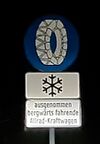
|
|
Snow chains required, except for motorcars (Class N) with winter tyres. | 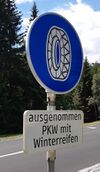
| |
|
Sign can be rotated. When turned to face to approaching traffic: Snow chains required, except for motorcars (Class N) with winter tyres. | ||
| Named chain change area | Dedicated chain change area, not a highway=rest_area
|
Note: image missing |
-
Vienna Convention:
snow_chains=required -
Canada (British Columbia):
snow_chains:hgv:conditional=required @ (Oct 1 - Apr 30 AND weight > 27000 kg) -
United States:
amenity=chain_change_area -
United States (California):
snow_chains=required -
Austria, Pötschenpass
snow_chains:conditional=required @ (ice AND weight>3.5); required @ (snow AND weight>3.5)
Rendering
Road
Bold/coloured/dashed(for snow_chains:conditional=* snow_chains:variable=*) highlighting in a cool, blue-ish hue. In zoom levels adequate to to importance of the road, start and end should be marked with a snow chain symbol ![]()
Chain Change Area
Like resting area, but cooler color (light violet) and with a symbol derived from chain change area ![]() . Can occur alongside parking sign, if parking is allowed and tagged.
. Can occur alongside parking sign, if parking is allowed and tagged.
Features/Pages affected
Related Topics
Informal listing for reference only, not part of the proposal.
- Additional Information regarding Road Signs and Legal Regulations (previously in the Discussion)
snowplowing=*mountain_pass=*winter_service=*Proposed features/amenity=chain baycanceled- Proposed features/Snow removal station
- Proposed features/Extended traffic signs tagging
Services
- Austrian traffic announcements (including snow chain requirements and closed roads) by ÖAMTC touring club, German: https://www.oeamtc.at/verkehrsservice/
Candidates
Snow chains required:
- B99 Katschbergstraße between Untertauern https://www.openstreetmap.org/way/543640321 https://www.openstreetmap.org/way/543640321 and Tweng https://www.openstreetmap.org/node/1847994578 https://www.mapillary.com/app/?lat=47.192245071087&lng=13.597593772183&z=17&pKey=452217472742213&focus=photo (variable traffic sign: https://www.mapillary.com/app/?lat=47.19065530335&lng=13.600630343744&z=17&pKey=200033871932766&focus=photo
Chain Change Areas:
- Austria
- B179 Fernpassstraße near Biberwier: Rest area with secondary use as chain-up area. Variable snow chains sign (horizontal prisms) at end of rest area on main road. https://www.openstreetmap.org/node/3247772931 https://www.mapillary.com/app/?lat=47.371611306488006&lng=10.87998742238699&z=17&pKey=829002147712748&focus=photo
- B99 Katschbergstraße near Niedertauern Anlegeplatz (chain-up), with traffic sign declaring it as chain-up area, with variable conditional snow chains sign (horizontal prisms) at begin of chain-up are area on main road https://www.openstreetmap.org/node/3247772931 https://www.mapillary.com/app/?lat=47.30096674063&lng=13.506476897759&z=17&pKey=196724175499711&focus=photo Ablegeplatz (chain-down) not declared, multi-use bay, but wide enough for chain-down https://www.openstreetmap.org/way/543640239
- B173 Eibergbundesstraße near Eiberg Articles: https://www.tt.com/artikel/12387597/kettenanlegeplatz-soll-winterchaos-verhindern https://www.tirol.gv.at/verkehr/baubezirksaemter/bba-kufstein/strassenbau/bau-strasse/archiv/kettenanlegeplatz-eiberg/ maybe https://www.openstreetmap.org/way/365879239 https://www.mapillary.com/app/?pKey=498512804607926
- S16 Arlberg Schnellestraße: Kettenanlegeplatz Bings https://www.openstreetmap.org/way/507523309
- Snow chains compulsory in Austria for vehicles > 3.5 t always at ice or snow. All primary roads (Autobahn, Schnellstraße) have chain-up areas where there is usually need in case of snow fall. TODO: get list/locations from ASFINAG.
- Germany
- OA9 Riedbergstraße near Obermaiselstein https://www.openstreetmap.org/way/305030048
- US
- Canada
Road signs
- Canada
- British Columbia: https://www.tranbc.ca/2011/02/03/do-i-need-to-chain-up-yes-and-maybe/
- Wikipedia Commons: https://commons.wikimedia.org/wiki/Category:Snow_chains-related_road_signs
- In Austria[2][1], Germany, Italy, Switzerland, Czeck Republic and other countries a traffic sign for "snow chains required" exists and is in common use.
- The UN Vienna Convention on Road Signs and Signals[3] defines
- a snow chain sign as D, 9 "SNOW CHAINS COMPULSORY" and E, 21 / E, 22 "CHAINS OR SNOW TYRES RECOMMENDED".
- Annex 5 F.7. "ROAD OPEN OR CLOSED" sign: Sign E, 21, "ROAD OPEN OR CLOSED", shall be used to show whether a mountain road, particularly a section leading over a pass, is open or closed; the sign shall be placed at the entry to the road or roads leading to the section in question. The name of the section of road (or pass) shall be inscribed in white. On the sign shown, the name "Furka" is given as an example. Panels 1, 2 and 3 shall be removable. If the section of road is closed, panel 1 shall be red and shall bear the inscription "CLOSED1 ; if the section is open, panel 1 shall be green and shall bear the inscription "OPEN", The inscriptions shall be in white and preferably in several languages. Panels 2 and 3 shall have a white ground with inscriptions and symbols in black. If the section of road is open, panel 3 shall remain blank and panel 2, according to the state of the road, shall either be blank, or display sign D, 9, "SNOW CHAINS COMPULSORY", or display symbol E, 22, "CHAINS OR SNOW TYRES RECOMMENDED". This symbol shall be black. If the section of road is closed, panel 3 shall show the name of the place up to which the road is open and panel 2 shall display, according to the state of the road, either the inscription "OPEN AS FAR AS", or symbol E, 22, or sign D, 9.
- One "Road Open or Closed" sign, for the "Furka" example in the Convention, is located at 500 m west of Hospental, CH.
- A similar sign for the three passes Furka, Grimsel and Gletch is located just north of Oberwald, CH.
- Road directions with "Road Open or Closed" style information can be found just south of Ulrichen, CH.
- The varible (prism) sign at Stuben am Arlberg https://www.openstreetmap.org/#map=19/47.14114/10.16098 https://mapillary.com/map/im/386033049354320
Local legislative requirements
By Good practice: Don't map your local legislation, if not bound to objects in reality this proposal is not concerned with regional or national regulations. Nevertheless it is important to interpret the actual road signage in context of the legal regulations.
a page similar to
could be created. A very good start would be https://de.wikipedia.org/wiki/Winterausrüstung_(Straßenverkehr) which is unfortunately German only.
In the mean time we collect Additional Information.
External discussions
Snow Chains
- Mailinglist [Talk-at] Mappen von Schneekettenpflicht 2019-11-09 (German
- )Forum users: German: Durchfahrt verboten/ohne Winterausrüstung
- Note 47436 Leberstraße
- How to tag access restriction on snow and ice on help.openstreetmap.org
- How to tag mountain_pass seasonal openings? on help.openstreetmap.org
- Routing mailinglist: [Routing] Snow chains required as temporary obstruction
- RFC on the Communitiy Forum
- Note in the Austrian Community Forum (German)
Variable Message
Mailinglist [Tagging] Billboard or something else 2019-10/11
Version/Changes
| Version | Change | Discussion Topics |
|---|---|---|
| 0 | Last Draft | |
| 1 |
|
|
| 2 |
|
|
| 3 |
|
|
| 4 |
|
|
|
Comments
Please comment on the discussion page.
Notes
- ↑ It turned out that differentiating all the ways traffic signals can be variable is a much bigger task than proposing snow chains. So, unfortunately out of scope here.
- ↑ Values like "none"' or "allowed" would implicate that there is no requirement at all for snow chains. This would possibly collide with legal requirements for the administrative area, which could state anything from "snow chains never allowed" to "required without exception on snow".
- ↑ Two reasons: 1) no snow in tunnels, thus only dammage to roads. 2) Speed is limited to 50 km/h, which is a hazard in a tunnel.
- ↑ Syntax for conditional has no "OR", these multiple conditions have to be stated separately.
- ↑
hazmat=*defines currently a condition withflashing_light, but that refers to flashing lights mounted ontop of the vehicle to be active flashing. Fixing this ambiguity is out of scope for this proposal. - ↑ Currently, we have no consistent tagging of variable traffic signs and regulations. Ideas where sketched out in the Discussion page.
- ↑ This may seem in conflict with
4wd_only=*, but there seems to be no defined or in use vehicle property that expresses non-offroad AWD-ness, and adding this to the proposal would go beyond the scope here. - ↑ Last chain-up area is easy to identify: If you see
1, you know it's your last chance. - ↑ This may seem in conflict with
4wd_only=*, but there seems to be no defined or in use vehicle property that expresses non-offroad AWD-ness, and adding this to the proposal would go beyond the scope here.
References
- ↑ 1.0 1.1 | StVO §54 Z. 5 lit. f "Diese Zusatztafel weist darauf hin, dass das Straßenverkehrszeichen bei Schneelage oder Eisbildung auf der Fahrbahn zu beachten ist." in RIS

- ↑ | StVO §51 lit. b Nr. 22 Gebotszeichen "SCHNEEKETTEN VORGESCHRIEBEN" in RIS

- ↑ https://treaties.un.org/Pages/ViewDetailsIII.aspx?src=TREATY&mtdsg_no=XI-B-20&chapter=11&Temp=mtdsg3&clang=_en

